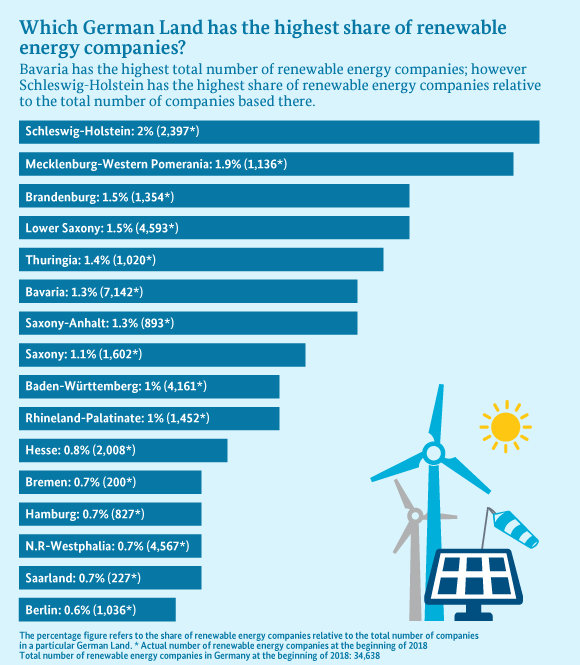The energy transition across the German Länder
Different approaches – one goal: all German Länder are working towards transforming their energy supply – irrespective of the parties they are governed by. However, different environments mean different strategies. A new report sheds light on the current state of play.
 © BMWi; data: Renewable Energies Agency (AEE)
© BMWi; data: Renewable Energies Agency (AEE)
The energy transition not only helps protect our climate and environment, it also serves as an engine for innovation and for a lasting modernisation of our country. The number of companies working in the renewable energy sector has increased over the last few years, climbing from just under 20,000 in 2009 to more than 34,600 today. Some 7,142 of these companies are based in Bavaria. However, proportionally, the largest number of renewable energy companies are based in Schleswig-Holstein (with 2 per cent) and Mecklenburg-Western Pomerania (with 1.9 per cent).
All 16 German Länder are driving forward the energy transition. The Renewable Energies Agency (AEE) publishes a regular status report entitled “Bundesländer mit neuer Energie” (German Länder using renewable energy) that describes what approaches each individual Land is taking to transform its energy supply.
Many roads lead to the energy transition
Each German Land is different. First of all, there is geography – which plays a key role for the generation of renewable energy. Solar irradiation is higher in the south of Germany, which means that solar installations erected in this part of the country generate more electricity than in the north. In the north of the country, a Land like Lower Saxony benefits from coastal winds. Bavaria is home to many rivers and inclines – which means that most of Germany’s hydropower is generated there. However, geography isn’t everything. Solar installations can also be profitable in the north of the country, as can be wind farms in the south. The 2018 status report shows that all German Länder are generating and using solar, wind and bio energy and that they are also using solar thermal energy to generate heat.
The report provides detailed information on Germany’s energy landscape including Länder profiles, figures, graphs, interviews and best practice examples. It also highlights what some German Länder are doing particularly well – achievements that are often little known in the other Länder. Baden Württemberg, for example, is often seen as a Land where a lot of solar energy is being generated, but, at a closer look, the Land is not only the second-largest user of photovoltaic and solar thermal energy – second only to Bavaria – but also a pioneer in the area of power to gas. Power-to-gas installations convert electrical power to methane, which can be used, for example, for low-carbon road transport. Lower Saxony is known as a Land where wind power is abundant – and it is also the German leader in the generation of electricity from biomass. However, it is not Lower Saxony but Bremen that generates the most wind power per square meter. Bavaria is the German Land that has the largest number of citizens’ energy undertakings. The solar battery storage unit with the largest capacity is based in Mecklenburg-Western Pomerania. And (not counting the city states), Saarland has the highest share of electrified railway lines in its overall railway system among all the German Länder, not counting the city states.

